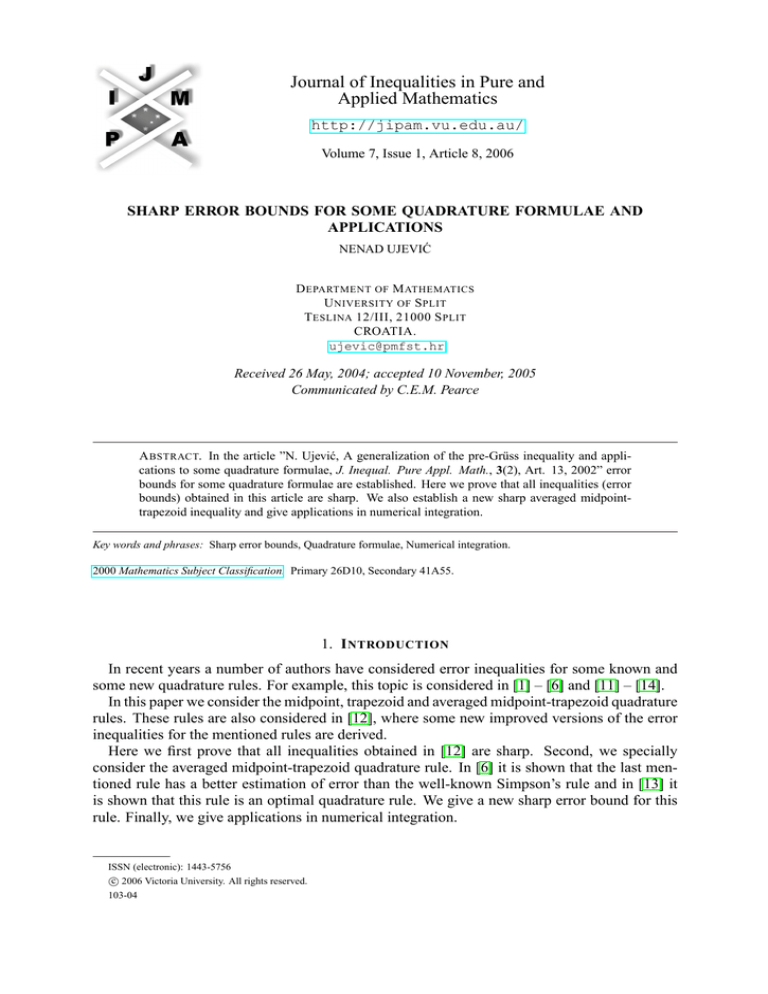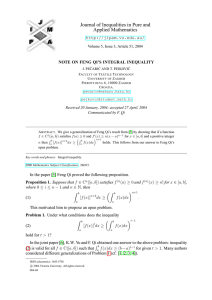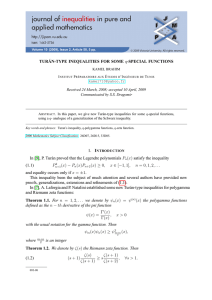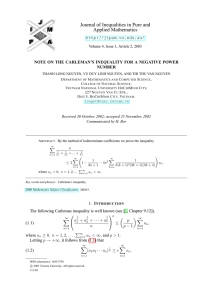
Journal of Inequalities in Pure and
Applied Mathematics
http://jipam.vu.edu.au/
Volume 7, Issue 1, Article 8, 2006
SHARP ERROR BOUNDS FOR SOME QUADRATURE FORMULAE AND
APPLICATIONS
NENAD UJEVIĆ
D EPARTMENT OF M ATHEMATICS
U NIVERSITY OF S PLIT
T ESLINA 12/III, 21000 S PLIT
CROATIA.
ujevic@pmfst.hr
Received 26 May, 2004; accepted 10 November, 2005
Communicated by C.E.M. Pearce
A BSTRACT. In the article ”N. Ujević, A generalization of the pre-Grüss inequality and applications to some quadrature formulae, J. Inequal. Pure Appl. Math., 3(2), Art. 13, 2002” error
bounds for some quadrature formulae are established. Here we prove that all inequalities (error
bounds) obtained in this article are sharp. We also establish a new sharp averaged midpointtrapezoid inequality and give applications in numerical integration.
Key words and phrases: Sharp error bounds, Quadrature formulae, Numerical integration.
2000 Mathematics Subject Classification. Primary 26D10, Secondary 41A55.
1. I NTRODUCTION
In recent years a number of authors have considered error inequalities for some known and
some new quadrature rules. For example, this topic is considered in [1] – [6] and [11] – [14].
In this paper we consider the midpoint, trapezoid and averaged midpoint-trapezoid quadrature
rules. These rules are also considered in [12], where some new improved versions of the error
inequalities for the mentioned rules are derived.
Here we first prove that all inequalities obtained in [12] are sharp. Second, we specially
consider the averaged midpoint-trapezoid quadrature rule. In [6] it is shown that the last mentioned rule has a better estimation of error than the well-known Simpson’s rule and in [13] it
is shown that this rule is an optimal quadrature rule. We give a new sharp error bound for this
rule. Finally, we give applications in numerical integration.
ISSN (electronic): 1443-5756
c 2006 Victoria University. All rights reserved.
103-04
2
N ENAD U JEVI Ć
2. M IDPOINT I NEQUALITY
Let I ⊂ R be a closed interval and a, b ∈ Int I, a < b. Let f : I → R be an absolutely
continuous function whose derivative f 0 ∈ L2 (a, b). We define the mapping
a+b (
t − 2a+b
,
t
∈
a, 2
3
Φ(t) =
t − a+2b
, t ∈ a+b
,b
3
2
such that Φ0 (t) = Φ(t)/ kΦk2 , where
kΦk22
b
Z
(Φ(t))2 dt =
=
a
(b − a)3
.
36
We have
Z
b
Φ0 (t)f 0 (t)dt
a
Z b
2
3
a+b
=√
f (a) + f
+ f (b) −
f (t)dt .
2
b−a a
b−a
In [12] we can find the following midpoint inequality
Z b
(b − a)3/2
a+b
≤
√
(b
−
a)
−
C1 ,
(2.1)
f
f
(t)dt
2
2 3
Q(f ; a, b) =
a
where
(
(2.2)
C1 =
2
kf 0 k2
[f (b) − f (a)]2
−
− [Q(f ; a, b)]2
b−a
) 12
.
Proposition 2.1. The inequality (2.1) is sharp in the sense that the constant
replaced by a smaller one.
1
√
2 3
cannot be
Proof. We first define the mapping
(
(2.3)
f (t) =
1 2
t,
2
t ∈ 0, 12
1 2
1
1
t
−
t
+
,
t
∈
,
1
2
2
2
and note that f is a Lipschitzian function.
On the other hand, each Lipschitzian function is an absolutely continuous function [10, p.
227].
Let us now assume that the inequality (2.1) holds with a constant C > 0, i.e.
Z b
a
+
b
f
≤ C(b − a)3/2 C1 ,
(2.4)
(b
−
a)
−
f
(t)dt
2
a
where C1 is defined by (2.2). Choosing a = 0, b = 1 and f defined by (2.3), we get
Z 1
1
1
1
f (t)dt = , f
=
24
2
8
0
such that the left-hand side of (2.4) becomes
1
(2.5)
L.H.S.(2.4) = .
12
1
√
We also find that C1 = 2 3 such that the right-hand side of (2.4) becomes
(2.6)
J. Inequal. Pure and Appl. Math., 7(1) Art. 8, 2006
C
R.H.S.(2.4) = √ .
2 3
http://jipam.vu.edu.au/
S HARP E RROR B OUNDS
From (2.4) – (2.6) we get C ≥
1
√
,
2 3
proving that C =
1
√
2 3
3
is the best possible in (2.1).
3. T RAPEZOID I NEQUALITY
Let I ⊂ R be a closed interval and a, b ∈ Int I, a < b. Let f : I → R be an absolutely
continuous function whose derivative f 0 ∈ L2 (a, b). We define the mapping
(
t − 5a+b
, t ∈ a, a+b
6
2
χ(t) =
a+b
t − a+5b
,
t
∈
,
b
6
2
such that χ0 (t) = χ(t)/ kχk2 , where
kχk22
Z
=
a
b
(b − a)3
(χ(t)) dt =
.
36
2
We have
Z
b
χ0 (t)f 0 (t)dt
a
Z b
6
1
a+b
=√
f (a) + 4f
+ f (b) −
f (t)dt .
2
b−a a
b−a
In [12] we can find the following trapezoid inequality:
Z b
f (a) + f (b)
(b − a)3/2
≤
√
(3.1)
(b
−
a)
−
f
(t)dt
C2 ,
2
2 3
P (f ; a, b) =
a
where
(
(3.2)
C2 =
2
kf 0 k2
[f (b) − f (a)]2
− [P (f ; a, b)]2
−
b−a
) 12
.
Proposition 3.1. The inequality (3.1) is sharp in the sense that the constant
replaced by a smaller one.
1
√
2 3
cannot be
Proof. We define the mapping
1
1
f (t) = t2 − t.
2
2
It is obvious that f is an absolutely continuous function. Let us now assume that the inequality
(3.1) holds with a constant C > 0, i.e.
Z b
f (a) + f (b)
(b − a) −
f (t)dt ≤ C(b − a)3/2 C2 ,
(3.4)
2
(3.3)
a
where C2 is defined by (3.2).
Choosing a = 0, b = 1 and f defined by (3.3), we get
Z 1
1
and f (0) = f (1) = 0.
f (t)dt =
12
0
Thus, the left-hand side of (3.4) becomes
1
(3.5)
L.H.S.(3.4) = .
12
The right-hand side of (3.4) becomes
C
(3.6)
R.H.S.(3.4) = √ .
2 3
J. Inequal. Pure and Appl. Math., 7(1) Art. 8, 2006
http://jipam.vu.edu.au/
4
N ENAD U JEVI Ć
From (3.4) – (3.6) we get C ≥
1
√
,
2 3
proving that
1
√
2 3
is the best possible in (3.1).
4. AVERAGED M IDPOINT-T RAPEZOID I NEQUALITY
Let I ⊂ R be a closed interval and a, b ∈ Int I, a < b. Let f : I → R be an absolutely
continuous function whose derivative f 0 ∈ L2 (a, b). We now consider a simple quadrature rule
of the form
Z b
f (a) + 2f a+b
+ f (b)
2
(4.1)
(b − a) −
f (t)dt
4
a
Z b
a+b
1
f (a) + f (b)
=
f
+
(b − a) −
f (t)dt = R(f ).
2
2
2
a
It is not difficult to see that (4.1) is a convex combination of the midpoint quadrature rule and
the trapezoid quadrature rule. In [6] it is shown that (4.1) has a better estimation of error than
the well-known Simpson’s quadrature rule (when we estimate the error in terms of the first
derivative f 0 of integrand f ). In [12] the following inequality is proved
Z b
f (a) + 2f a+b + f (b)
(b − a)3/2
2
√
(4.2)
(b − a) −
f (t)dt ≤
C3 ,
4
4 3
a
where
"
(4.3)
C3 =
2
kf 0 k2
1
[f (b) − f (a)]2
−
−
b−a
b−a
f (a) − 2f
a+b
2
2 # 12
+ f (b)
.
Proposition 4.1. The inequality (4.2) is sharp in the sense that the constant
replaced by a smaller one.
1
√
4 3
cannot be
Proof. We first define the mapping
(
f (t) =
(4.4)
1 2
t
2
− 14 t,
t ∈ 0, 12
1 2
3
1
1
t
−
t
+
,
t
∈
,
1
2
4
4
2
and note that f is a Lipschitzian function.
Let us now assume that the inequality (4.2) holds with a constant C > 0, i.e.
Z b
f (a) + 2f a+b + f (b)
2
(4.5)
(b − a) −
f (t)dt ≤ C(b − a)3/2 C3 ,
4
a
where C3 is defined by (4.3). Choosing a = 0, b = 1 and f defined by (4.4), we get
Z 1
1
1
f (t)dt = − , f (0) = f (1) = f
=0
48
2
0
such that the left-hand side of (4.5) becomes
We also find that C3 =
1
.
48
such that the right-hand side of (4.5) becomes
L.H.S.(4.5) =
(4.6)
1
√
4 3
C
R.H.S.(4.5) = √ .
4 3
(4.7)
From (4.5) – (4.7) we get C ≥
1
√
,
4 3
J. Inequal. Pure and Appl. Math., 7(1) Art. 8, 2006
proving that C =
1
√
4 3
is the best possible in (4.2).
http://jipam.vu.edu.au/
S HARP E RROR B OUNDS
5
5. A S HARP E RROR I NEQUALITY
In [12] we can find the following inequality
S(f, g)2 ≤ S(f, f )S(g, g),
(5.1)
where
Z
(5.2)
S(f, g) =
a
b
1
f (t)g(t)dt −
b−a
b
Z
b
Z
f (t)dt
g(t)dt
a
a
1
−
kΨk2
Z
b
Z
f (t)Ψ(t)dt
a
b
g(t)Ψ(t)dt
a
and Ψ satisfies
b
Z
Ψ(t)dt = 0,
(5.3)
a
while
b
Z
2
Ψ2 (t)dt.
kΨk =
a
In [14] we can find a variant of the following lemma.
Lemma 5.1. Let f ∈ C 1 [a, c], g ∈ C 1 [c, b] be such that f (c) = g(c). Then
(
f (t), t ∈ [a, c]
h(t) =
g(t), t ∈ [c, b]
is an absolutely continuous function.
Theorem 5.2. Let f : [0, 1] → R be an absolutely continuous function whose derivative f 0 ∈
L2 (0, 1). Then
Z 1
1
1
f (t)dt −
f (0) + 2f
+ f (1) (5.4) 4
2
0
s
2
2
1
1
1
2
≤ √
kf 0 k − 2 f
− f (0) − 2 f (1) − f
.
2
2
4 3
The inequality (5.4) is sharp in the sense that the constant
one.
1
√
4 3
cannot be replaced by a smaller
Proof. We define the functions
(5.5)
(
t − 14 , t ∈ 0, 12
t − 34 , t ∈ 12 , 1
(
t,
p(t) =
and
(5.6)
Ψ(t) =
t ∈ 0, 12
.
t − 1, t ∈ 12 , 1
It is not difficult to verify that
Z
1
Z
p(t)dt =
(5.7)
0
J. Inequal. Pure and Appl. Math., 7(1) Art. 8, 2006
1
Ψ(t)dt = 0.
0
http://jipam.vu.edu.au/
6
N ENAD U JEVI Ć
We also have
1
Z
2
kpk =
(5.8)
p2 (t)dt =
1
,
48
Ψ2 (t)dt =
1
,
12
0
1
Z
2
kΨk =
(5.9)
0
1
Z
p(t)Ψ(t)dt =
(5.10)
0
1
.
48
From (5.1), (5.2) and (5.3) we get
2
Z 1
Z 1
Z 1
1
0
0
p(t)Ψ(t)dt
f (t)Ψ(t)dt
(5.11)
p(t)f (t)dt −
kΨk2 0
0
0
"
Z 1
2 #
1
2
≤ kpk −
p(t)Ψ(t)dt
kΨk2
0
"
Z 1
2
Z 1
2 #
1
2
× kf 0 k −
f 0 (t)dt −
f 0 (t)Ψ(t)dt
.
2
kΨk
0
0
Integrating by parts, we obtain
Z 1
Z
0
p(t)f (t)dt =
(5.12)
1
2
1
3
f (t)dt +
t−
f 0 (t)dt
1
4
0
2
Z 1
1
1
=
f (0) + 2f
+ f (1) −
f (t)dt
4
2
0
0
1
t−
4
Z
0
and
Z
1
Z
0
1
2
f (t)Ψ(t)dt =
(5.13)
0
1
Z
0
(t − 1)f 0 (t)dt
tf (t)dt +
1
2
0
Z 1
1
=f
−
f (t)dt.
2
0
We introduce the notations
Z
i=
(5.14)
1
f (t)dt,
0
(5.15)
1
1
q=
f (0) + 2f
+ f (1) .
4
2
From (5.11) – (5.15) and (5.8) – (5.10) it follows that
2
1
1
f
−i
(5.16)
(q − i) −
4
2
"
2 #
1
1
2
≤
kf 0 k − [f (1) − f (0)]2 − 12 f
−i
64
2
J. Inequal. Pure and Appl. Math., 7(1) Art. 8, 2006
http://jipam.vu.edu.au/
S HARP E RROR B OUNDS
7
or
(5.17)
2
1
1
1
4 2
2
0 2
i − 2qi + q +
[f (1) − f (0)] − kf k + 16 f
− 32f
q ≤ 0.
3
48
2
2
2
If we now introduce the notations
(5.18)
β = −2q,
(5.19)
2
4 2
1
1
1
2
0 2
γ= q +
[f (1) − f (0)] − kf k + 16 f
− 32f
q
3
48
2
2
then we have
i2 + βi + γ ≤ 0.
(5.20)
Thus, i ∈ [i1 , i2 ], where
i1 =
−β −
p
β 2 − 4γ
,
2
i2 =
−β +
p
β 2 − 4γ
.
2
In other words,
β
− −
2
p
β 2 − 4γ
β
≤i≤− +
2
2
p
β 2 − 4γ
2
or
p 2
β
i + ≤ β − 4γ .
2
2
(5.21)
We have
(5.22)
"
2
2 #
1
1
1
0 2
β − 4γ =
kf k − 2 f
− f (0) − 2 f (1) − f
.
12
2
2
2
From (5.21) and (5.22) we easily find that (5.4) holds.
We have to prove that (5.4) is sharp. For that purpose, we define the function
1
( 1 2 1
1
t
−
t
+
,
t
∈
0, 2
2
4
32
(5.23)
f (t) =
.
1 2
3
9
1
t
−
t
+
,
t
∈
,
1
2
4
32
2
From Lemma 5.1 we see that the above function is absolutely continuous. If we substitute the
above function in the left-hand side of (5.4) then we get
(5.24)
L.H.S.(5.4) =
1
.
48
If we substitute the above function in the right-hand side of (5.4) then we get
(5.25)
R.H.S.(5.4) =
1
.
48
From (5.24) and (5.25) we conclude that (5.4) is sharp.
J. Inequal. Pure and Appl. Math., 7(1) Art. 8, 2006
http://jipam.vu.edu.au/
8
N ENAD U JEVI Ć
Theorem 5.3. Let f : [a, b] → R be an absolutely continuous function whose derivative f 0 ∈
L2 (a, b). Then
Z b
a
+
b
b
−
a
(5.26) f (a) + 2f
+ f (b) f (t)dt −
4
2
a
2
(b − a)3/2
a+b
2
0 2
√
≤
kf k −
f
− f (a)
b−a
2
4 3
2 ! 12
a+b
2
.
f (b) − f
−
b−a
2
√
The above inequality is sharp in the sense that the constant 1/(4 3) cannot be replaced by a
smaller one.
Remark 5.4. We have better estimates than (5.26). For example, we have the inequality
Z b
b − a
1 0
a
+
b
≤ kf k (b − a)2 .
(5.27)
f
(a)
+
2f
+
f
(b)
−
f
(t)dt
∞
4
8
2
a
However, note that the estimate (5.27) can be applied only if f 0 is bounded. On the other hand,
the estimate (5.26) can be applied for absolutely continuous functions if f 0 ∈ L2 (a, b).
There are many examples where we cannot apply the estimate (5.27) but we can apply (5.26).
R1√
3
Example 5.1. Let us consider the integral 0 sin t2 dt. We have
√
2t cos t2
3
f (t) = sin t2 and f 0 (t) = √
3
3 sin2 t2
such that f 0 (t) → ∞, t → 0 and we cannot apply the estimate (5.27). On the other hand, we
have
Z 1
Z
4
t2 cos t2 1 dt
16
2
0
√
[f (t)] dt ≤ max
≤ ,
3
2
9 t∈[0,1] sin t
9
sin t2
0
0
4
0
i.e. kf k2 ≤ 3 and we can apply the estimate (5.26).
6. A PPLICATIONS IN N UMERICAL I NTEGRATION
Let π = {x0 = a < x1 < · · · < xn = b} be a given subdivision of the interval [a, b] such that
hi = xi+1 − xi = h = (b − a)/n. We define
n−1 X
b−a 0 2
(6.1)
σn (f ) =
kf k2 − (f (xi+1 ) − f (xi ))2
n
i=0
2 # 12
xi + xi+1
− f (xi ) − 2f
+ f (xi+1 )
,
2
(6.2)
"
2
n−1
X
b−a 0 2
xi + xi+1
ηn (f ) =
kf k2 − 2 f
− f (xi )
n
2
i=0
− 2 f (xi+1 ) − f
J. Inequal. Pure and Appl. Math., 7(1) Art. 8, 2006
xi + xi+1
2
2 # 12
http://jipam.vu.edu.au/
S HARP E RROR B OUNDS
9
and
(6.3)
12
1
0 2
2
ωn (f ) = (b − a) kf k2 − (f (b) − f (a))
.
n
Theorem 6.1. Let π be a given subdivision of the interval [a, b] and let the assumptions of
Theorem 5.2 hold. Then
(6.4)
Z
n−1 b
X
h
x
+
x
i
i+1
f (t)dt −
f (xi ) + 2f
+ f (xi+1 ) a
4 i=0
2
b−a
b−a
≤ √ σn (f ) ≤ √ ωn (f ),
4 3n
4 3n
where σn (f ) and ωn (f ) are defined by (6.1) and (6.3), respectively.
Proof. We have
Z xi+1
Z xi+1
h
xi + xi+1
(6.5)
f (xi ) + 2f
+ f (xi+1 ) −
f (t)dt =
Ki (t)f 0 (t)dt,
4
2
xi
xi
where
Ki (t) =
t−
3xi +xi+1
,
4
t ∈ xi , xi +x2 i+1
t−
xi +3xi+1
,
4
t∈
xi +xi+1
,
x
i+1
2
.
From Proposition 4.1 we obtain
Z xi+1
h
x
+
x
i
i+1
f (xi ) + 2f
+
f
(x
)
−
f
(t)dt
i+1
4
2
xi
1
h3/2 h
2
≤ √ kf 0 k2 − (f (xi+1 ) − f (xi ))2
h
4 3
2 # 12
1
xi + xi+1
−
f (xi ) − 2f
+ f (xi+1 )
.
h
2
If we sum (6.5) over i from 0 to n − 1 and apply the above inequality then we get
Z
n−1 b
hX
xi + xi+1
f (t)dt −
f (xi ) + 2f
+ f (xi+1 ) a
4 i=0
2
" n−1
h3/2 X 0 2 1
≤ √
kf k2 − (f (xi+1 ) − f (xi ))2
h
4 3 i=0
1
−
h
f (xi ) − 2f
xi + xi+1
2
2 # 12
+ f (xi+1 )
.
From the above relation and the fact h = (b − a)/n we see that the first inequality in (6.4) holds.
J. Inequal. Pure and Appl. Math., 7(1) Art. 8, 2006
http://jipam.vu.edu.au/
10
N ENAD U JEVI Ć
Using the Cauchy inequality we have
21
n−1 X
1
2
0 2
kf k2 − (f (xi+1 ) − f (xi ))
(6.6)
h
i=0
# 12
"
n−1
X
1
2
≤ n kf 0 k2 −
(f (xi+1 ) − f (xi ))2
b − a i=0
12
1 1
2
0 2
.
≤ n kf k2 −
(f (b) − f (a))
b−an
Since
2
xi + xi+1
f (xi ) − 2f
+ f (xi+1 )
2
1
2
≤ kf 0 k2 − (f (xi+1 ) − f (xi ))2 ,
h
we easily conclude that the second inequality in (6.4) holds, too.
2
kf 0 k2
1
1
− (f (xi+1 ) − f (xi ))2 −
h
h
Remark 6.2. The second inequality in (6.4) is coarser than the first inequality. It may be
used to predict the number of steps needed in the compound rule for a given accuracy of the
approximation. Of course, we shall use the first inequality in (6.4) to obtain the error bound.
Note also that in this last case we use the same values f (xi ) to calculate the approximation
Rb
of the integral a f (t)dt and to obtain the error bound and recall that function evaluations are
generally considered the computationally most expensive part of quadrature algorithms.
Theorem 6.3. Under the assumptions of Theorem 6.1 we have
Z
n−1 b
X
h
x
+
x
i
i+1
f (t)dt −
f (xi ) + 2f
+ f (xi+1 ) a
4
2
i=0
b−a
b−a
≤ √ ηn (f ) ≤ √ ωn (f ),
4 3n
4 3n
where ηn (f ) is defined by (6.2).
Proof. The proof of this theorem is similar to the proof of Theorem 6.1. Here we use Theorem
5.3.
R EFERENCES
[1] G.A. ANASTASSIOU, Ostrowski type inequalities, Proc. Amer. Math. Soc., 123(12) (1995), 3775–
3781.
[2] P. CERONE, Three points rules in numerical integration, Nonlinear Anal.-Theory Methods Appl.,
47(4) (2001), 2341–2352.
[3] P. CERONE AND S.S. DRAGOMIR, Midpoint-type rules from an inequalities point of view, Handbook of Analytic-Computational Methods in Applied Mathematics, Ed.: G. Anastassiou, CRC
Press, New York, (2000), 135–200.
[4] P. CERONE AND S.S. DRAGOMIR, Trapezoidal-type rules from an inequalities point of view,
Handbook of Analytic-Computational Methods in Applied Mathematics, Ed.: G. Anastassiou, CRC
Press, New York, (2000), 65–134.
J. Inequal. Pure and Appl. Math., 7(1) Art. 8, 2006
http://jipam.vu.edu.au/
S HARP E RROR B OUNDS
11
[5] D. CRUZ-URIBE AND C.J. NEUGEBAUER, Sharp error bounds for the trapezoidal rule and Simpson’s rule, J. Inequal. Pure Appl. Math., 3(4) (2002), Art. 49. [ONLINE: http://jipam.vu.
edu.au/article.php?sid=201].
[6] S.S. DRAGOMIR, P. CERONE AND J. ROUMELIOTIS, A new generalization of Ostrowski’s
integral inequality for mappings whose derivatives are bounded and applications in numerical integration and for special means, Appl. Math. Lett., 13 (2000), 19–25.
[7] A. GHIZZETTI
1970.
AND
[8] A.R. KROMMER
1998.
A. OSSICINI, Quadrature Formulae, Birkhäuser Verlag, Basel/Stuttgart,
AND
C.W. UEBERHUBER, Computational Integration, SIAM, Philadelphia,
[9] D.S. MITRINOVIĆ, J. PEČARIĆ AND A.M. FINK, Classical and New Inequalities in Analysis,
Kluwer Acad. Publ., Dordrecht/Boston/London, 1993.
[10] I.P. NATANSON, Theory of Functions of Real Variables, Nauka, Moscow, 1974.
[11] C.E.M. PEARCE, J. PEČARIĆ, N. UJEVIĆ AND S. VAROŠANEC, Generalizations of some inequalities of Ostrowski-Grüss type, Math. Inequal. Appl., 3(1) (2000), 25–34.
[12] N. UJEVIĆ, A generalization of the pre-Grüss inequality and applications to some quadrature formulae, J. Inequal. Pure Appl. Math., 3(1) (2002), Art. 13. [ONLINE: http://jipam.vu.edu.
au/article.php?sid=165].
[13] N. UJEVIĆ, An optimal quadrature formula of open type, Yokohama Math. J., 50 (2003), 59–70.
[14] N. UJEVIĆ, Two sharp Ostrowski-like inequalities and applications, Meth. Appl. Analysis, 10(3)
(2004), 477–486.
[15] N. UJEVIĆ AND A.J. ROBERTS, A corrected quadrature formula and applications, ANZIAM J.,
45(E) (2004), E41–E56.
J. Inequal. Pure and Appl. Math., 7(1) Art. 8, 2006
http://jipam.vu.edu.au/









